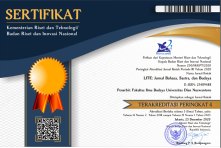AN ANALYSIS OF "ORIFLAME" WOMAN PERFUME ADVERTISEMENTS
Abstract
Slogan and image usually represent a product in an advertisement. The
slogan consists of phrases or sentences, while the image consists of people or else
with the background. This research was conducted to find out the tools to convey
the message in Oriflame perfume advertisements and to discover the hidden
messages by using those tools in the advertisements. Searle’s illocutionary acts
theory (1977) and Peirce's semiotics theory (1931) were used as frameworks for
analysis. A descriptive qualitative was used to analyze the data. The result shows
that from verbal tool analysis, there are 17 illocutionary acts found in the taglines
and body copies of the advertisements. The first illocutionary act found in the data
is assertive. It is because the advertiser wants their product to be known and to
persuade the readers by using information, description, claim, and statement. The
second is directive because the advertiser gives command to the readers
especially woman to use the perfume. From non verbal tool analysis, the
researchers found signs in each background image which then were turned into
object and interpretant through a cognition process. From verbal and non verbal
tools, the researchers discovered the hidden messages of the Oriflame perfume
advertisements. The conclusion is that the advertiser created different images of
each advertisement. The images support the tagline and the body copy of
advertisement. The advertiser wants the consumers to be able to choose their own
perfume based on their characteristics or what they want to be like.
slogan consists of phrases or sentences, while the image consists of people or else
with the background. This research was conducted to find out the tools to convey
the message in Oriflame perfume advertisements and to discover the hidden
messages by using those tools in the advertisements. Searle’s illocutionary acts
theory (1977) and Peirce's semiotics theory (1931) were used as frameworks for
analysis. A descriptive qualitative was used to analyze the data. The result shows
that from verbal tool analysis, there are 17 illocutionary acts found in the taglines
and body copies of the advertisements. The first illocutionary act found in the data
is assertive. It is because the advertiser wants their product to be known and to
persuade the readers by using information, description, claim, and statement. The
second is directive because the advertiser gives command to the readers
especially woman to use the perfume. From non verbal tool analysis, the
researchers found signs in each background image which then were turned into
object and interpretant through a cognition process. From verbal and non verbal
tools, the researchers discovered the hidden messages of the Oriflame perfume
advertisements. The conclusion is that the advertiser created different images of
each advertisement. The images support the tagline and the body copy of
advertisement. The advertiser wants the consumers to be able to choose their own
perfume based on their characteristics or what they want to be like.
Keywords
advertisement, illocutionary acts, Oriflame, semiotics, pragmatics
Full Text:
PDFDOI: https://doi.org/10.33633/lite.v11i1.1352
Article Metrics
Abstract view : 318 timesPDF - 1454 times
Refbacks
- There are currently no refbacks.
Copyright (c) 2015 Novantia Amandhita Fajar, Nina Setyaningsih
ISSN Online: 2548-9588
This work is licensed under a Creative Commons Attribution-ShareAlike 4.0 International License.
This journal is published by Universitas Dian Nuswantoro, Semarang, Indonesia.
Indexing & Archiving:
IN COLLABORATION WITH:
Indonesian Pragmatics Association
Konsorsium Program Studi Jepang Indonesia
Center for Foreign Language Training
Asosiasi Studi Pendidikan Bahasa Jepang Indonesia







































